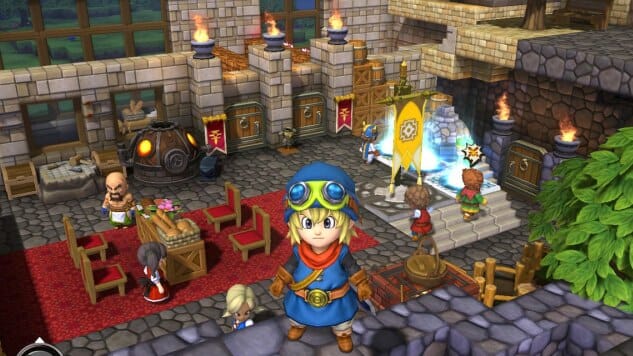Dragon Quest Builders Breathes Life into Minecraft‘s Monotony

The magic of Minecraft wasn’t lost on me, but it never had staying power for me. I could spend hours building houses and castles, filling in every detail and hunting rare materials, but where some saw freedom, I saw aimlessness. Minecraft’s livelihood is artificial; no matter how grand my abode or vast my voxel-based empire became, it was empty. Interaction was limited to multiplayer servers, where you would have to roleplay to get the desired effect, with a band of willing participants. Otherwise, I could build all the houses I wanted, but they would never be inhabited.
Dragon Quest Builders unashamedly lifts concepts wholesale from Minecraft, and even from other block-based imitators like Cubeworld. Yet it all fits together better than any prior attempt to add direction to Minecraft’s massive sandbox. Set in a world where the bad end of the first Dragon Quest came to fruition, you are tasked as Builder to resurrect the empires and cities destroyed by monsters.
There’s a tongue-in-cheek element to the player happening to be the only one who knows how to build on a scale larger than trinkets, but it plays out well. Where Dragon Quest Builders shines is its lived-in city that you build up over time. You are tasked with a reasonable plot of land that is yours, and anything built within the light of your banner will be recognized as part of your city.
When you build a room with a bed, light source, chamber pot and door, the game will recognize your construct as a bedroom, and permit NPCs to sleep there at night. This is the core loop of Dragon Quest Builders: expand your city, attracting more citizens with your buildings, and defend it from the monsters. As your village expands, your citizens make requests of you, often to create new buildings for them to use, or will create the next crafting station you need for better gear and items.
These NPCs are your people, though. They live in your city, and help to defend against invading monsters who are unpleased with humanity’s second wind. When you build a masonry studio, villagers will shuffle in and out throughout the day, constructing extra resources like doors, chests and pots for you to use in building new rooms. In the kitchen, they will cook food, and a watering hole might provide you with purified water.
It’s a little daunting at times, how many different buildings you can construct for your denizens. There are many ways to go about leveling up your city and bringing in more villagers, though many of the optional buildings are more cosmetic. You’ll always need a crafting room, a kitchen and some sort of bedroom. What about your villagers, though? Do you build each a private bedroom, designated and discrete? Or do you construct an inn instead, everyone sleeping in close proximity and quick to react when monsters strike?
The type of anxiety I imagine only civil engineers experience sets in, as you build bigger and grander buildings, counting out blocks and laying out physical blueprints to fill in like a Lego-by-the-numbers set. As your city expands, the third-person camera can become a hindrance, as it struggles to adapt to snug ceilings and tight corridors. (A hint: I learned early on that it’s best to make roofs at least four blocks above ground level, to avoid claustrophobia.)
But that evolving, shifting home is what makes Dragon Quest Builders so engaging. In Minecraft, the impetus was on me to find new ventures. This mostly involved digging through wikis and YouTube tutorials, scrubbing video to find redstone machines I could imitate or strange farming automation methods. My focus was always on the end result; I could imitate and share, celebrating my own accomplishment, but that TNT cannon was never going to be put to any real use. The world was ambivalent to my presence, and didn’t care that I had built a massive castle. No army of creepers and skeleton archers would try to surmount my walls, and no wayward NPC would find a home within one of the many lavish bedrooms I had built.
-

-

-

-

-

-

-

-

-

-

-

-

-

-

-

-

-

-

-

-

-

-

-

-

-

-

-

-

-

-

-

-

-

-

-

-

-

-

-

-









































